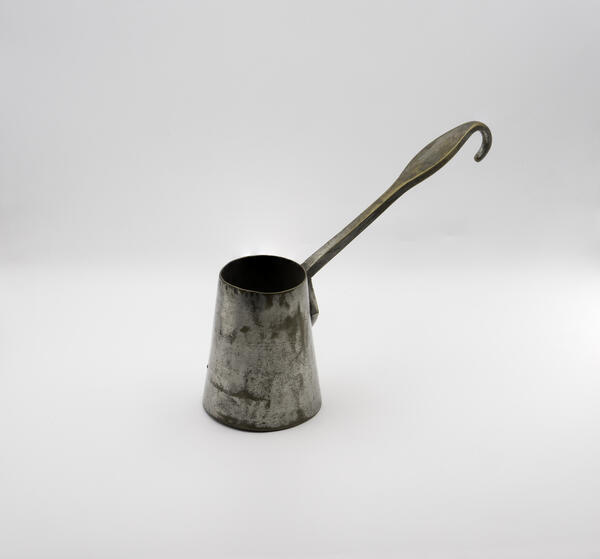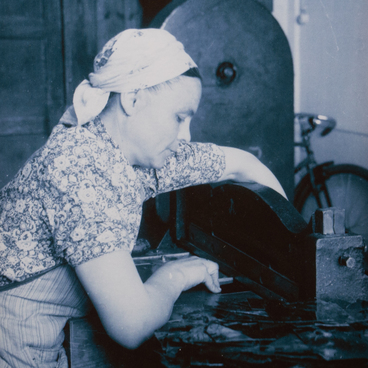This unusual object from the museum collection is called ‘mera’ (measure). It was used to measure the portion of wine given to workers who worked in the gold mines of the Yenisei Province in the 19th and early 20th centuries.
The region was famous for its gold mines. Gold began to be extracted there in the 1830s. Gradually, the so-called mines' systems of the northern and southern taiga were formed. The first gold miners were hired workers who came mainly from the peasantry. First of all, they were attracted by high earnings. In the middle of the 19th century, one miner earned from 100 to 350 rubles in assignations per season. This was the name of the banknotes which were cheaper than silver coins and which were worth up to 100 rubles in silver terms. For comparison, at the time, one could buy 2.5 kilograms of beef for one ruble.
Some mines had more primitive conditions and operated all year round, most of the fields were operated seasonally — from May to November. But, of course, the working conditions were terrible: the miners worked for 13-15 hours a day, lived in huts, which they built from logs or stone, and received clothes and other necessary things from the employer as payment. In this situation, many found salvation in alcohol. In Siberia, by this period, there was an established tradition of making alcoholic beverages, as well as its large-scale implementation in numerous drinking establishments. According to the historian Vasily Zinoviev, ‘this gives reason to say that there is a fairly developed system of the wine trade in Siberia and the possibilities of wine distillation from local bread’. Already in the 18th century, due to the growing population and the lack of ‘state-owned wine’, wine farmers appeared — a kind of intermediaries between the state and the consumer. That was how the excise-handout system was organized. In addition, since 1714, by the decree of Peter I, people of all ranks were allowed to distill wine in Siberia. In the 19th century, the sale of vodka in the cities finally took shape of a network of tavern establishments. The green boards' inscriptions screamed: ‘On tap and takeaway’.
The ban to sell alcohol to workers was often violated. People of the villages adjacent to the mines were so-called ‘alcohol carriers’ (one who sold alcohol illegally in gold-mining district). The owners of the mines themselves turned a blind eye to the ban, knowing full well that this was a great way to stifle workers' discontent with unbearable working conditions. Vasily Ivanovich Semevsky, a researcher of the life of gold-mining workers, wrote: ‘Workers bring home only a small part of their earnings, and leave most of them in pubs located with strategic knowledge of the matter at all exits from the taiga’.
On holidays, and some mines every day, the miners received a ‘wine portion’, which was measured out with special scoops — the kind that is presented in the museum collection. At that time, the shkalik (old Russian unit of liquid measure) was not the name of a small bottle, as it is now, but a measure of the volume of 61.5 milliliters. In addition to this gratuitous portion of vodka, a miner had the opportunity to get more alcohol from the employer, but for money.
The press of those years talked a lot about the practice of workers' inebriation. The owners of the mines, wanting to sell alcohol at a high price, received an extra profit, and then they fined employees for alcoholism. Even after the end of the seasonal work, the miners continued to drink at home — this became a serious problem for the peasants themselves and their family members.
The region was famous for its gold mines. Gold began to be extracted there in the 1830s. Gradually, the so-called mines' systems of the northern and southern taiga were formed. The first gold miners were hired workers who came mainly from the peasantry. First of all, they were attracted by high earnings. In the middle of the 19th century, one miner earned from 100 to 350 rubles in assignations per season. This was the name of the banknotes which were cheaper than silver coins and which were worth up to 100 rubles in silver terms. For comparison, at the time, one could buy 2.5 kilograms of beef for one ruble.
Some mines had more primitive conditions and operated all year round, most of the fields were operated seasonally — from May to November. But, of course, the working conditions were terrible: the miners worked for 13-15 hours a day, lived in huts, which they built from logs or stone, and received clothes and other necessary things from the employer as payment. In this situation, many found salvation in alcohol. In Siberia, by this period, there was an established tradition of making alcoholic beverages, as well as its large-scale implementation in numerous drinking establishments. According to the historian Vasily Zinoviev, ‘this gives reason to say that there is a fairly developed system of the wine trade in Siberia and the possibilities of wine distillation from local bread’. Already in the 18th century, due to the growing population and the lack of ‘state-owned wine’, wine farmers appeared — a kind of intermediaries between the state and the consumer. That was how the excise-handout system was organized. In addition, since 1714, by the decree of Peter I, people of all ranks were allowed to distill wine in Siberia. In the 19th century, the sale of vodka in the cities finally took shape of a network of tavern establishments. The green boards' inscriptions screamed: ‘On tap and takeaway’.
The ban to sell alcohol to workers was often violated. People of the villages adjacent to the mines were so-called ‘alcohol carriers’ (one who sold alcohol illegally in gold-mining district). The owners of the mines themselves turned a blind eye to the ban, knowing full well that this was a great way to stifle workers' discontent with unbearable working conditions. Vasily Ivanovich Semevsky, a researcher of the life of gold-mining workers, wrote: ‘Workers bring home only a small part of their earnings, and leave most of them in pubs located with strategic knowledge of the matter at all exits from the taiga’.
On holidays, and some mines every day, the miners received a ‘wine portion’, which was measured out with special scoops — the kind that is presented in the museum collection. At that time, the shkalik (old Russian unit of liquid measure) was not the name of a small bottle, as it is now, but a measure of the volume of 61.5 milliliters. In addition to this gratuitous portion of vodka, a miner had the opportunity to get more alcohol from the employer, but for money.
The press of those years talked a lot about the practice of workers' inebriation. The owners of the mines, wanting to sell alcohol at a high price, received an extra profit, and then they fined employees for alcoholism. Even after the end of the seasonal work, the miners continued to drink at home — this became a serious problem for the peasants themselves and their family members.



